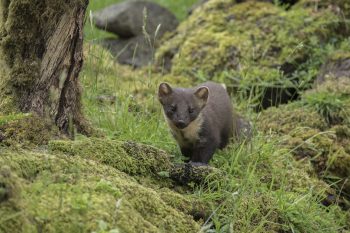
Pine marten ©Robert Cruickshanks
The pine marten Martes martes is a member of the Mustelid (weasel) family, along with weasels, stoats, badgers, polecats and otters. Pine martens are excellent climbers and are similar in size to a small domestic cat, with a long bushy tail. They have dark brown fur all over, with a creamy-coloured/pale-yellow throat and chest, which is also referred to as a ‘bib’. The bib can have distinctive patterns, which differ between individuals, helping conservationists to identify individual pine martens.
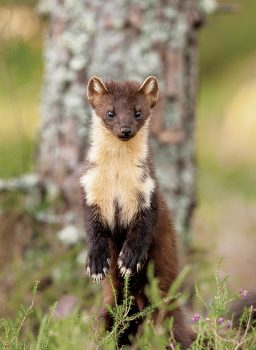
Pine marten showing a unique bib pattern ©James Moore
Today, pine martens are found throughout much of northern and central Scotland, as far south as the Central Belt, with some populations in southern Scotland (Dumfries and Galloway, and the Scottish borders). Pine martens have begun to spread over the Scottish/English border and re-colonise areas of Northumberland and Cumbria.
Elsewhere in England, there are pine martens of unknown origin in Shropshire, Hampshire and Devon. These pine martens are likely the result of escapes from private collections or covert/unofficial releases that may not have followed national and international guidelines. This type of release is unlikely to result in a sustainable population of pine martens, they risk the welfare of the animals involved, and can lead to negative perceptions of species translocations and reintroductions.
Between 2015 and 2017, VWT translocated 51 pine martens from Scotland to mid-Wales, leading to the re-establishment and subsequent spread of a viable marten population in Wales. Between 2019 and 2021, Gloucestershire Wildlife Trust, in partnership with VWT and Forestry England, translocated 35 pine martens to the Forest of Dean in Gloucestershire.
Pine martens prefer three dimensionally complex habitat and have excellent climbing skills that have evolved in forested habitats. They prefer to den in tree cavities in which they rest and breed, but can find shelter in thick vegetation, rocky terrain and manmade structures.
Female pine martens look for safe, secure and dry places to give birth to and raise their young (kits). They do not excavate their own dens. Ideally these natal den sites are found in tree cavities, elevated off the ground to protect them from fox predation. Manmade structures, uninhabited and inhabited, may also be used, particularly where there is a lack of suitable tree cavities in the marten’s territory. Pine martens will also use specially designed den boxes to breed and raise their kits in. VWT has been involved in designing and trialling different types of den box designs with successful results.

Pine marten den box ©Ruth Hanniffy
No, pine martens are territorial and typically solitary, marking their territories with fragrantly scented scats (faeces). Adults only come together for a short period in summer to mate. If more than one pine marten are seen together, this is most likely to be a female and her kits, or young siblings that often stay together during their first year. Females can have between one and four kits, however two to three is most common and many will not make it through their first year. Pine martens are slow breeders, only typically reproducing in their third year.
Pine martens have a varied, seasonal diet and will eat what is locally plentiful. This may include small mammals (such as mice, voles and squirrels), fruit and berries, birds, eggs, insects and carrion (dead animals). They are small to medium sized and do not attack or eat livestock, such as lambs, which has been incorrectly reported in other countries and never documented with evidence.
Pine martens and red squirrels have evolved together throughout their Eurasian range in a natural predator-prey relationship, though studies in Britain and Ireland highlight a low occurrence of red squirrel in pine marten diet. Research in Ireland and Scotland by Dr Emma Sheehy and colleagues found that in some areas where pine martens are present, non-native grey squirrels are negatively affected, and red squirrels may benefit from their presence (Sheehy & Lawton, 2014; Sheehy et al., 2018). However there is also evidence that these effects only occur when there is a relatively high density of pine martens (Sheehy & Lawton, 2014; Sheehy et al., 2018; Flaherty & Lawton, 2019; Twining, Montgomery & Tosh, 2020). NB Sheehy & Lawton, 2014 paper is not available to download for free.
Recent research also indicates that, where this effect occurs, pine martens could play an important role in reducing grey squirrel density thus preventing the transmission of deadly squirrelpox virus to recovering endangered red squirrels (Slade et al., 2023). There is significant interest in the role that pine martens can play in reducing the numbers of grey squirrels, which cause significant ecological and economic damage. However, the dynamics between the three species is complex and influenced by many factors, and there is more to be learnt about these interactions.
Although pine martens mainly predate on small mammals such as voles, birds form a part of their varied diet, and so wild birds and game birds (reared for shooting) may also be predated upon. Before being hunted and trapped to near extinction, pine martens evolved and co-existed with all our native birds in the wild for thousands of years, and they play an important role in the food chain. Pine martens naturally occur in very low densities in the landscape and will take advantage of food sources that are locally abundant; they are therefore most likely to predate on bird species that are common, and less likely to have an impact on rare birds. They are opportunistic and will predate on birds’ eggs if they come across a nest, something that many other native carnivores and bird species also do.
Pine martens are good climbers and may take game birds and poultry if they can access pens, however simple preventive measures can make pens predator proof, such as clearing overhanging branches and using netting over the top of pens (in addition to normal predator proofing techniques).
VWT have produced a leaflet on How to Exclude Pine Martens from Game and Poultry Pens
As pine martens eat what is most commonly and abundantly available, they are unlikely to significantly impact bats or hazel dormice. There is little evidence that pine martens regularly predate on bats, although there is a possibility that pine martens may use the same buildings to den in that bats also roost in. As with pine martens, hazel dormice typically exist in low population densities in woodland. Hazel dormice nest boxes have small entrance holes facing towards the tree trunk and lids are typically secured in place, to protect from predators.
If you see a pine marten in England, Wales, or Southern Scotland and the Scottish borders please report it to us. If possible, please try and take a photograph or video. If you’re in Central or Northern Scotland, the local biological records centre, will be interested to receive the record.
The pine marten is part of our rich wildlife heritage. It plays an integral role in a healthy, balanced woodland ecosystem and can be an important predator of pest species, such as grey squirrels. As a bonus, re-establishing pine martens in England and Wales, and encouraging pine marten recovery in the Scottish borders also has the potential to benefit the rural economy, as has been the case in Scotland, through the creation of tourism opportunities for people who are keen to see this captivating woodland animal.
Reintroduction is the release of a species from an existing healthy population, into suitable areas in the wild where it is capable of survival, for the purpose of species conservation. Reinforcement is used when animals are released into areas where there is a (usually small) existing population of the same species. The IUCN and Statutory Nature Conservation Organisations (SNCOs) oversee reintroductions and reinforcements in the UK.
Although the pine marten population in Scotland was spreading southwards, it was unlikely that it would spread to re-colonise Wales and central and southern England due to the large conurbations in northwest and central England, as well as a lack of appropriate habitat in some of these areas.
Therefore, following years of extensive habitat suitability modelling, surveys, disease risk analysis and community engagement work, and following the relevant guidance and requirement from the IUCN and SNCOs, VWT translocated pine martens from healthy Scottish populations to suitable habitats in Wales and later into the Forest of Dean (England) where the populations had become so small and isolated that they were very unlikely to recover naturally without intervention.
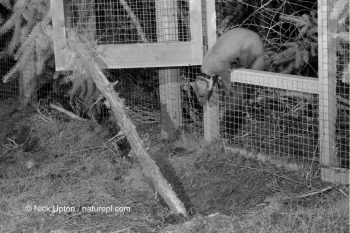
PM25 taking first steps to explore new home in Wales ©Nick Upton
Pine martens are listed under Schedule 5 of the Wildlife and Countryside Act (1981), which means that it is illegal to intentionally trap, kill or injure pine martens, or disturb their dens. Any activity that could disturb pine martens, such as trapping animals or monitoring den boxes, must be done under a licence from the relevant statutory body.
Pine martens are largely solitary and normally exclude members of the same sex from their home ranges. Home range size varies widely according to habitat. In Britain a single male home range can vary from 33km² in upland spruce to 3km² in more productive, lowland woodland. For females this is smaller, from 10km² to just under 1km² in these habitats. This means that many woodlands will not be large enough to sustain a viable population of pine martens. Pine martens need entire landscapes to thrive, not just individual sites.
Any proposed translocation of pine martens must be considered very carefully and comply with IUCN, NatureScot and DEFRA guidelines on translocations, whether for reintroduction or reinforcement (re-stocking). The importance of animal welfare and health screening is emphasised in these guidelines, as is the requirement for a detailed ecological assessment to maintain favourable conservation status of this protected species.
Pine martens are beginning to naturally recover their population in parts of Britain where they had previously been absent for hundreds of years in Wales, the Welsh-English borders, the far north of England and the Scottish-English borders, thanks in part to reintroduction efforts.
VWT has worked with NatureScot and Natural England to produce the Long-term Strategic Recovery Plan for Pine Martens in Britain, (also linked below). The advice is that the strategy should be followed by projects contributing to the recovery of pine martens in Britain. This includes supporting natural population recovery where pine martens are able to naturally recolonise an area.
VWT’s Martens on the Move project (2024-2027) is also supporting the long-term natural recovery of pine martens by engaging with and educating local communities and land owners about pine martens. In addition, we will be developing and leading a national den box monitoring scheme to enable population monitoring and future research.
Long-term Strategic Recovery Plan for Pine Martens in Britain
Download the Advice note: Release of pine martens into the wild in Britain PDF
IUCN/SSC Reintroduction Specialist Group
NatureScot (formerly Scottish Natural Heritage)
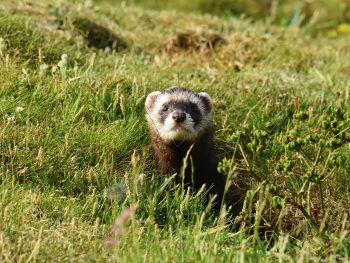
Polecat ©Moss Taylor
Polecats have a wide distribution across Europe, from Britain and Portugal in the west to the Ural Mountains of Russia in the east, but they have never been found in Ireland.
In Britain, the polecat population is recovering and expanding its range, following a severe historical decline. A species range is the geographical area in which the species can be found. Polecats are currently widespread in Wales, central and much of southern England, with isolated populations in northern England and parts of Scotland (Perthshire, Fife and Argyll). See distribution map here or read this report.
Yes. The polecat is the ancestor of the domestic ferret. Polecats and ferrets can interbreed, creating polecat-ferret hybrid offspring that are fertile. This can occur when domestic or working ferrets escape or are lost into the wild, or where feral ferret populations are established (although this is rare in Britain), creating opportunities for ferrets to mate with wild polecats.
Polecat-ferret hybrids typically occur at the edge of the polecat’s range and in reintroduced populations. It’s thought that the presence of ferret genes among the polecat population is not a threat to the population and true polecats appear to ‘outcompete’ hybrids in the long term.
Polecats and ferrets can be distinguished by genetic analysis and also by their phenotype (pelage/fur) characteristics, although this is not 100% accurate. Polecats and ferrets are quite different behaviourally too. Ferrets tend to be more tame and docile and generally lack the awareness skills needed to survive in the wild.
See our leaflet Polecats and Ferrets how to tell them apart
Polecats are fairly generalist and not dependent on any one habitat type. In Britain, they are more numerous in lowland landscapes, but across their range in mainland Europe they inhabit a variety of habitats including riparian vegetation, wetlands, grasslands, pastures, agricultural land and montane pine forests. Polecats use existing structures for den sites, such as rabbit burrows, haystacks and log piles.
In Britain, most of the polecat’s diet comprises rabbits. They also eat rats and other small rodents, amphibians and birds.
Polecats are opportunistic and adaptable. They will visit gardens and may take food left out for other animals, such as foxes or badgers. Polecats occasionally den in gardens, under decking, sheds or in compost piles.
Polecats are not a threat to cats or dogs and will avoid confrontation with other animals where possible. Polecats are smaller than domestic cats and dogs and are likely to come off worse in any encounter with the two.
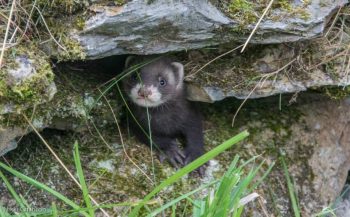
Young polecat living on a farm in north Wales ©Nikki Charlton
Polecats can be attracted to concentrations of vulnerable livestock, such as poultry, penned pheasants and captive wildfowl and may kill birds if they can gain easy access to poultry and game pens.
Several husbandry techniques are available to prevent polecats accessing pens or coops, such as securing domestic fowl at night in solid, custom-built hen-houses, and nightly closure of ‘pop-holes’ – the ground level access points that allow birds to re-enter pheasant pens. Polecats may squeeze through gaps as small as 4cm, so pens should be built with no gaps larger than this and wire mesh and wooden henhouses should be checked regularly for gaps or weak points. Although polecats can climb, most attempts to break into game and poultry pens occur at ground level.
Following severe declines and range contraction as a result of heavy persecution during the 19th Century, the polecat population in Britain has been increasing and expanding into areas of its former range. This recovery is likely due to a combination of factors – reduced gamekeeping pressures during the First World War, the banning of gin traps in 1958, and legal protection under the Wildlife and Countryside Act 1981. Elsewhere in Europe, polecats are decreasing.
Although polecats appear to be increasing, they are still at risk from a number of threats. A major cause of mortality in polecats is vehicle collisions, particularly during the mating season (February-March) and juvenile dispersal (September-October).
Polecats are also vulnerable to secondary rodenticide poisoning. They become exposed to second-generation anticoagulant poison through eating rats and other small mammals which have ingested poison. It’s not yet known whether this will affect the polecat’s ongoing recovery in Britain.
Polecats may also die or become injured in traps set for other species, such as grey squirrels and weasels. Although polecats have no natural predators in Britain they are occasionally killed by dogs.
.
The polecat is listed on Schedule 6 of the Wildlife and Countryside Act 1981, which prohibits certain methods of killing or taking of the animal.
If you have seen a polecat, please report it to your local Biological Records Centre (almost every county has one) or log it on The Mammal Society’s Mammal Mapper App on your phone.
NB We will be launching our fourth National Polecat Survey in January 2024… so please keep a record of your sightings!